If you would like to come on one of my walks, a couple of places have just become free on two of my final walks until late next spring. Details and links are:
For this week’s post, I am in Whitechapel, on the Commercial Road, a short distance east from Aldgate East Underground Station, where, in 1952, my father took the following photo:

The view is looking east along Commercial Road. My father was standing in a cleared bomb site, looking across to where a café was parked. The café looks as if it was once a tram or coach, however after a quick bit of Googling, I could not find anything similar, so any information would be appreciated.
Roughly the same view today (although the street in the foreground is not the same in both photos, I had to stand slightly to the east to avoid trees, parked lorries and other obstructions on the pavement that obscured the view):

I have marked the location and direction of view by the red circle and arrow in the following extract from the 1948 revision of the OS map, with the blue line showing the location of the café (‘Reproduced with the permission of the National Library of Scotland“):
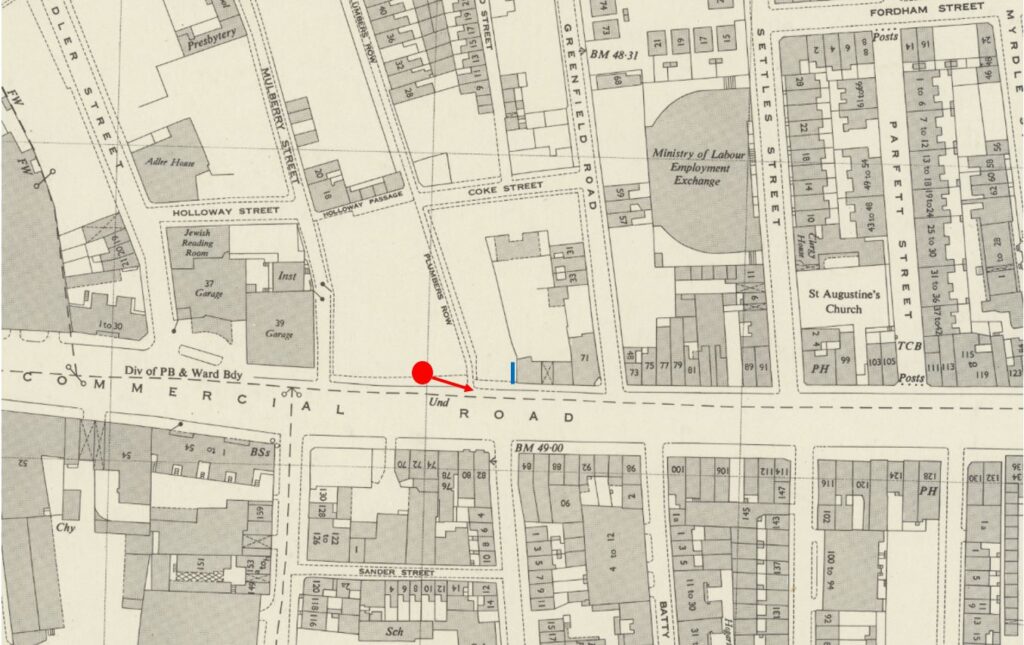
The map shows the amount of bomb damage in this part of Whitechapel with plenty of blank space where bomb damaged buildings had been cleared.
The map also shows the name of the narrow lane in the foreground of my father’s photo. This was Plumbers Row, a lane that went much further north from Commercial Road up to the junction of Fieldgate Street and Whitechapel Road, however today, the southern section has been built over, covering much of the area along Commercial Road with a large new building over the bombsite where my father was standing, where the café was located, and up to Greenfield Road.
Although nothing remains of the view to the left of Commercial Road in my father’s photo, much of the right hand side of the road is still recognisable. In the following extract from the 1952 photo, there is a row of terrace houses of difference sizes:
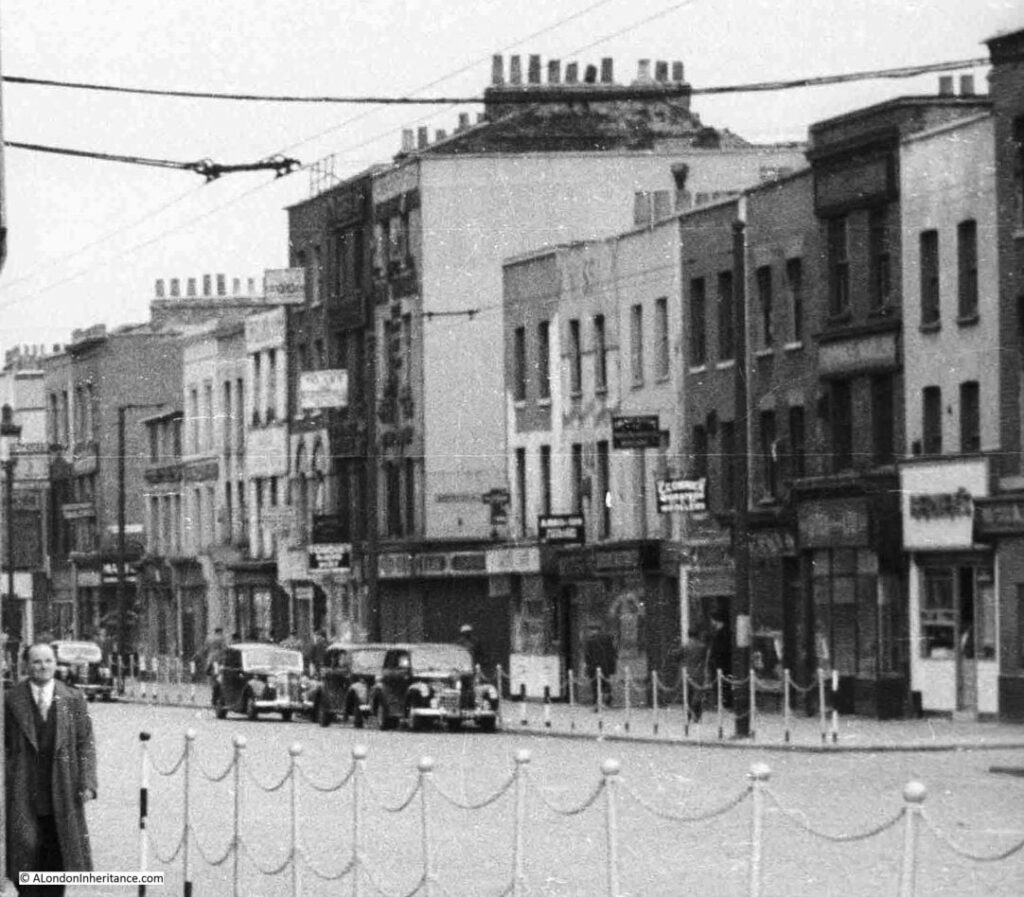
In the above photo, from the centre to the right, there is a row of terrace houses of the same height. These still remain today, although they have all had an additional floor added at roof level as shown in the same view, seventy one years later in 2023:
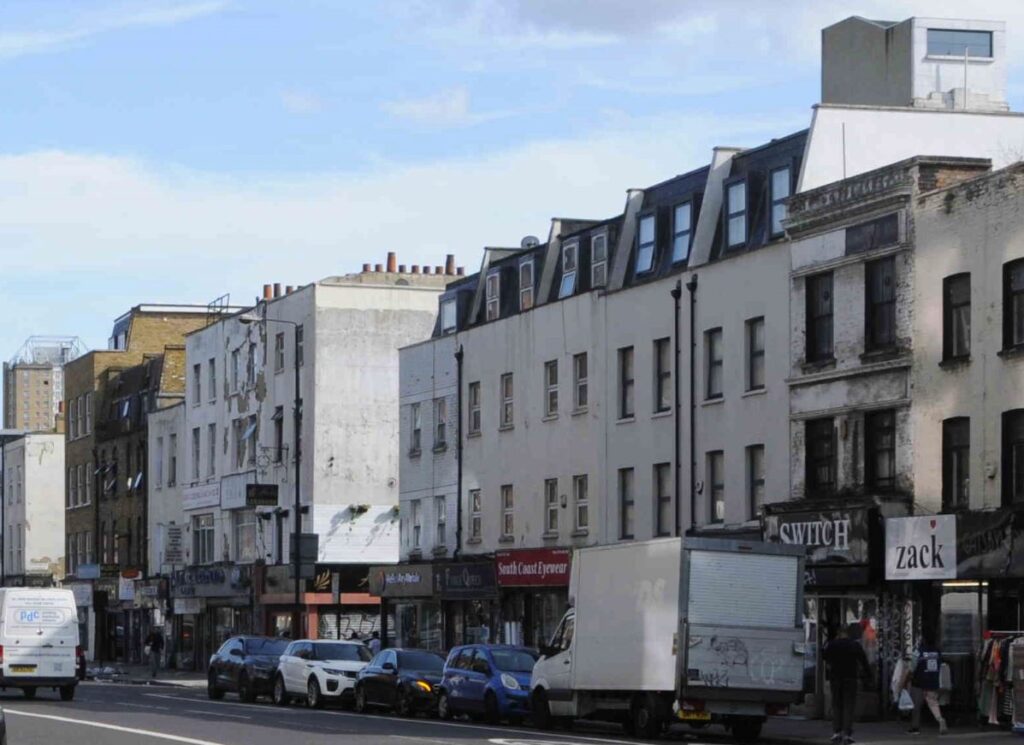
The building to the right of the terrace is still the same, as are the taller terrace buildings to the left.
The reason my father took this particular photo must have been the rather unusual café on the bomb site. On the front there are adverts for a number of soft drinks:
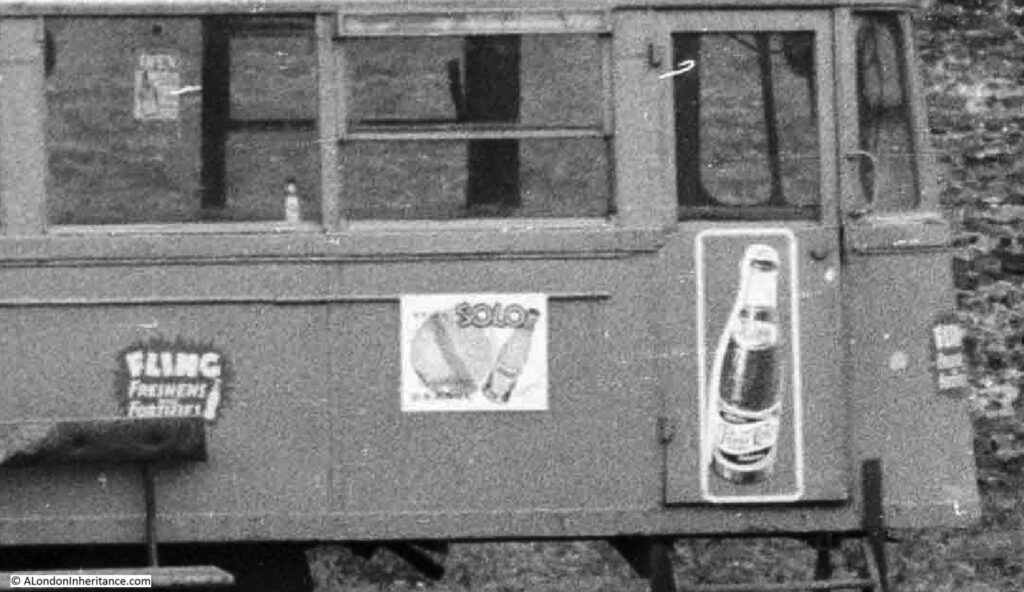
On the left is an advert for Fling with their slogan that it “Freshens and Fortifies”. It was sold in a bottle that was very similar to that used by Coke, and from what I have read it seems to have been a cheaper version of the American drink.
In the middle is an advert for Solo, an orange drink, highlighted by the illustration of a cut orange in the advert.
One the right is an advert for Pepsi Cola, which ten years later would rebrand as just Pepsi. There was also a large advert for Pepsi Cola on the left of the café, which seems to have had a small kitchen area at the rear:
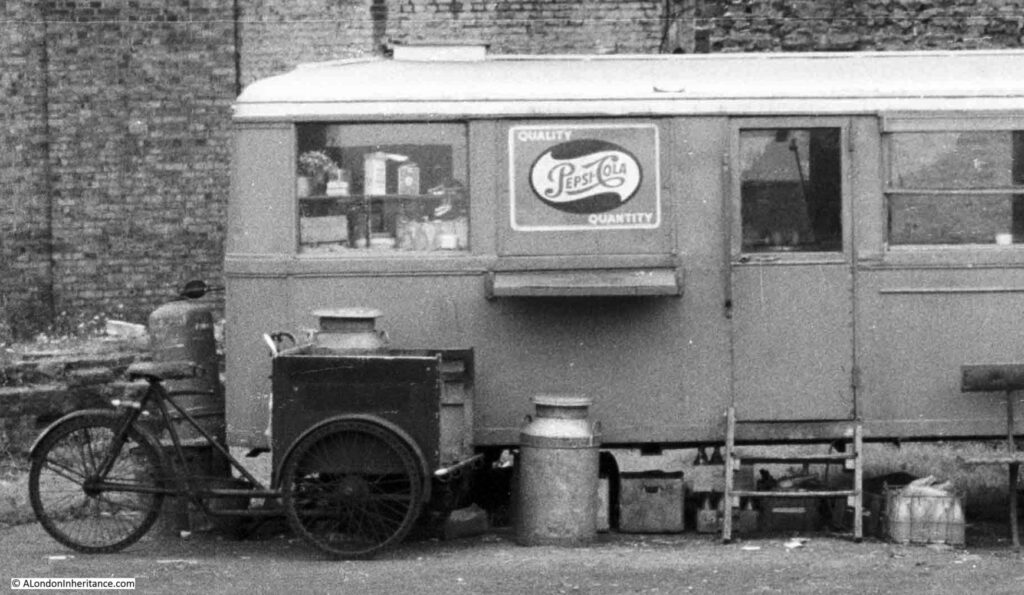
There are also a couple of milk churns, one of which is in a box which appears to be mounted at the front of a bike. No idea whether this was to bring milk to the café, or whether milk was distributed to local residents from the café.
The building behind the café had a large advert for Liquid Sunshine Rum – Pure Jamaica:
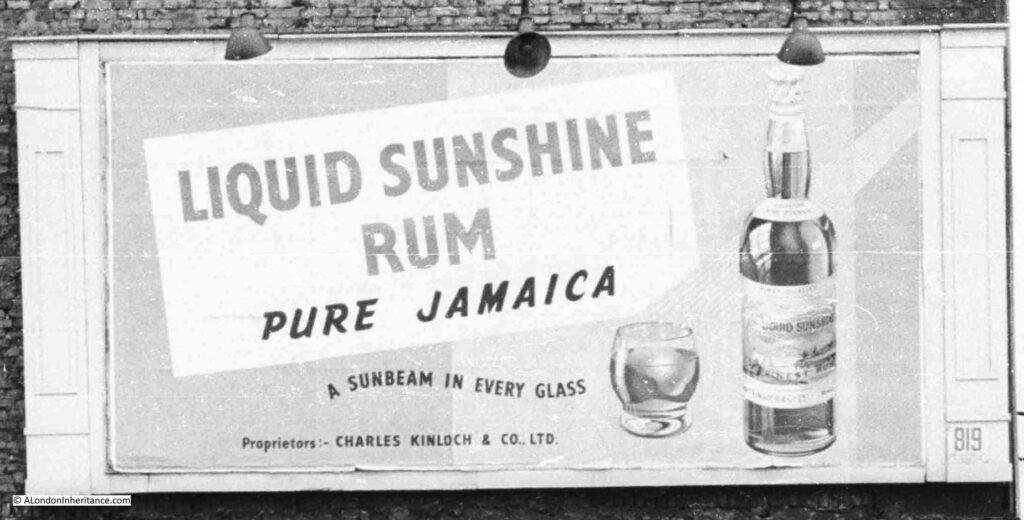
This was a brand of Charles Kinloch who were wine and spirits merchants, who seem to date from the early 1860s.
They were an independent company until 1957, five years after the above photo, when they were taken over by the brewer Courage.
I cannot find out for how long Liquid Sunshine Rum was sold, however their rum trade seems to have taken a back seat during the 1960s as wine started to become a popular alcoholic drink.
Charles Kinloch had plenty of adverts in the press and on TV targeting the low cost wine market, and they seem to have focused on lower cost Spanish wines, rather than more expensive French. Their marketing was on the pleasure of drinking their wines, rather than “putting by or putting one over the next door neighbour”.
In 1966 they advertised that “My Spanish wines are for drinkers, not collectors, says Charles Kinloch, They’re Good and Cheap”. Cheap was 9 shillings, 3 pence a bottle. In 1966 they also had an advertising slot on ITV titled “The Great Charles Kinloch Wine Robbery”, and in newspapers had full page adverts providing helpful lists of which of their wines to use for different types of food, and courses during a dinner.
At the time, their head office was in Kinloch House, Cumberland Avenue, London NW10. As Courage was taken over several times during the following decades, the Kinloch brand gradually disappeared.
And this is where research gets really frustrating as I found a Charles Kinloch building close to the site of the 1952 photo, the subject of this post.
Almost on the opposite side of the road, from the 1952 and my 2023 photo is Back Church Lane that runs from Commercial Road to Cable Street.
Along Back Church Lane was a large Charles Kinloch warehouse, and the building remains, along with the name Charles Kinloch in large letters along the top of the building.
It is frustrating as I found this during final research for the post on the Saturday prior to publication, so did not have time to go and take a photo, so to make up for the lack of a photo, you can see the building at this link to Google StreetView.
A relatively short post this week, but I am pleased to have found and photographed another of the locations of my father’s early photos.

I think that the cafe has been made from the upper deck of a London bus. I don’t know the make but the roof shape and rake looks like an old bus to me.
A bit more research tells me it’s an AEC Regent. The windows are the same too.
I believe you’re correct – an AEC Regent I. Good spot!
Good morning, another fantastic post. Takes me back to my childhood much later in the mid to late 70s. My father was a construction worker and he used to take me to work with him on a Saturday morning and we would always end up in a cafe in the east end followed by a pub. Packet of crisps and a coke in the corner.
Thanks for the posts
Good morning, I also have a memory of redundant vehicles being used in a similar fashion to your photograph but in Cardiff city I lived there from 1946 to 1957 from.when we moved to Welwyn Garden City my memories of Cardiff were of a lot of instances where various vehicles etc. were repurposed after the war including a large area of the fabled “used car lots”. Also that cycle cart puts me in mind of an ice cream seller who used to call where we used to live in the Clive Street area of Grangetown Cardiff . So I could well believe that such a vehicle could be used for selling milk. My father also had a camera but sadly all of his photos are lost, apart from the odd holiday snaps.
Thankyou.
The cafe looks like an old tube carriage to me ? There were a lot of old train carriages, lorries etc recycled in the 1950s. I visited a family friend who had altered a removal lorry into a ‘caravan’ in that era. It was situated at Pett Level for many years.
Another excellent post – thank you.
A brilliant post as ever. To take one high quality historical photograph and then to explore the places, maps, customs, culture, and historical notes from bonafide sources and weave everything into a coherent and evidence based narrative makes for a brilliant slow read that stays in the mind. And represents genuine research that belongs in an archive one day. Thank you
I really enjoyed this piece this week and the Charles Kinloch building being transformed into residential homes makes my heart happy as I love old buildings restored.
What a fascinating article. I’ve never heard of those drinks before.
Interesting, looks like an old Belgian (maybe) tram.
I think the van was still there in the mid seventies. We use to stop for a greasy bacon roll in the early hours of a Sunday morning on the way home to Fieldgate Mansions! We called it Frenchies, cos the guy who ran it, think George, broken glasses frames and lank greasy hair, would put eggs, bacon, tomatoes etc into half a French stick. Quite unusual in those days
The old photos are wonderful.
Thanks for this evocative post. The ‘large new building’ mentioned as occupying the former site cleared because of bomb damage, became the London College of Furniture, where I was a student in the 1980s. We understood that it had been built as a shoe factory.
The cafe would seem to be from the top deck of a 1931 A1 Class “Diddler” Trolleybus. I can’t immediately find an good offside illustration but nearside can be seen in this example from the London Transport Museum – https://www.ltmuseum.co.uk/collections/collections-online/vehicles/item/1981-527 showing the alternate thick window pillars, with a quarter-window at the front (the right handside in the photo)
A wonderful post! I worked on commercial road in the late eighties. It’s great to see these before and after carnations. Your level of detail is remarkable, your father would be so gratified I’m sure, that you care so much. And the graphics!!! Lovely!
Have seen this photo before.
It’s been identified as the top deck of a London trolleybus – one of the former London United Tramways ‘Diddler’ type, which were London’s first trolleybuses in 1931, replacing trams in the Kingston area.
The very first survives in the care of the London Transport Museum – https://www.ltmuseum.co.uk/collections/collections-online/vehicles/item/1981-527
They were replaced by new trolleybuses c. 1948/49
There is a slight resemblance to the ‘Feltham’ class of tram that was also built by the Union Construction Company at Feltham – https://www.ltmuseum.co.uk/collections/collections-online/vehicles/item/1981-532-part-0
I think the bike and churns were used to bring water to the site. The milk came in bottles; you can see the crate of empties next to the steps.
I love how those buildings were “prettied up” with the addition of the rooftop level, but still left standing. Thanks for the post.
Good to read that the original Charles Kinloch warehouse/office is being repurposed and not flattened with a bland monstrosity in its place
In the google street view of the Charles Kinloch building, it’s rather nice to see that the newer building to the right has been sympathetically designed to sit well in the street and looks good alongside our building.
Another terrific post, thank you. My transport expert colleagues suggest that the café was originally the top desk of a London Transport ‘Diddler’ trolleybus. Ken Blacker’s book “The London Trolleybus, Volume 2” features a photo of a similar ‘vehicle’ situated at Aldgate. Could be the same one. Apparently, some of the Diddlers were dismantled at nearby Bow, so this may be where the café came from.
Another first-class post. Although I grew-up near Russell Square, deaths in the family led to my being sent to an LCC children’s home on the East India Dock Road, Langley House, which seems to have disappeared completely from our collective memory, as the few online searches I’ve made have failed to turn up any reference to it at all – perhaps I’m not doing it right. Anyway, the reason I mention this is that my daily commute between Langley House and Highbury County Grammar School took me through Aldgate East Station, although I don’t recall the cafe. Our lunchtime tuck-shop (do schools still have tuck-shops?) sold the Fling drink that you mentioned in your post. The drink came in the usual thick, reusable, glass bottles of the time, was paler in colour than Coke or Pepsi, and was sweet, with a sugary flavour that suggested no particular fruit. I can’t imagine why it was called “Fling”, but, as eleven-year-olds, we had found that, if you inverted and shook the newly-opened bottle, with an index finger over its mouth, it was possible to squirt a jet of the stuff over a distance of several yards, usually targetting a classmate, and resulting immediate tit-for-tat retaliation. This was, of course, a silly waste of one’s pocket-money, but the enjoyment and satisfaction derived from the activity must have been sufficient to balance the inevitable beating received from Seniors or teachers caught in the crossfire, and the scolding received upon returning home for tea at the end of the day, sticky from head to foot. Thank you for reminding me.
Thanks again for another interesting post. The cafe does appear to be a tram type vehicle which has been converted for cafe use. I wonder if it was previously a specialized maintenance type tram rather than a passenger tram?
An excellent aerial view of this site taken in 1955 can be seen in BFA059521. The tram car can clearly be seen and stands where a Static Water Tank was erected when the corner was bombed. You father did a wonderful job in visually preserving the WW2 post war period. Thankvyou.
I would suggest that the tearoom was purpose built basically as it appears. There was something similar to this near my primary school in 1948 off Gloucester Road, Kensington. Where the Pepsi sign is, it looks like a hatch with a serving shelf below it. I would suggest that the milk churns were for water carrying as there would have been no external plumbing facilities. It still has the wheels underneath? During WW2 there was a lot of mobile accomodation made for instant army camps, docks and airfields, including WVS tea vans and air traffic control towers. What caught my interest was the chain link fencing along the street, presumably a way of stopping parking at the time?
Best regards Richard
Thank you for the post, a little more upon sunshine rum can be found at:
https://thelonecaner.com/tag/charles-kinloch-co/
The box holding the milk churn was fixed to the back of the bicycle. Perhaps it was used to return empty churns to the dairy, though full churns would probably be far too heavy.
Lovely juxtaposition of photos, including your father’s original of the cafe. Such a shame that when areas are ‘improved’, most of the character and interest is ironed out too. You mention the bombsite from which the picture was taken; I wonder how many are left in inner London, today? While at school in central London in the ’70s, they seemed to be everywhere.